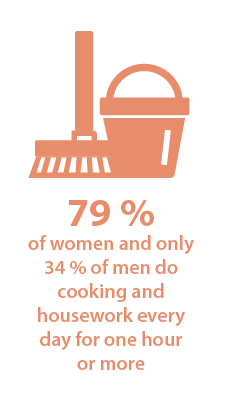Uneven impact of family life on women and men
Not only does family type determine the overall time that women and men spend caring for their children, grandchildren, older people or people with disabilities, it also impacts gender inequalities in caring. When different types of families are compared, a distinct difference is observed. While 85 % of women living in a couple with children do at least 1 hour of childcare work per day, this only holds true for 67 % of men. The gender gap increases to 60 p.p. for food preparation and housework, with 92 % of women cooking for at least 1 hour every day.
One-parent families also reflect gender differences, as lone fathers are more likely to live with older children. This partially explains that while 76 % of lone mothers do childcare work every day, only 38 % of lone fathers do likewise. For this family type, the gender gap in domestic work narrows to 24 p.p., with 87 % of lone mothers cooking and/or doing housework every day for at least 1 hour a day.
 Family formation plays a role when analysing the situation of women and men from different age groups. The age cohort most likely to do unpaid care work every day is that of 25-49-year-olds, the group most likely to have young children. Altogether, 61 % of women of this age group care for others every day compared to 39 % of men. In fact, women spend more time in care work than men throughout their life. The gender gap among young people (15-24 years old) is lower (12 p.p.), with just 3 % of young men doing care work every day.
Family formation plays a role when analysing the situation of women and men from different age groups. The age cohort most likely to do unpaid care work every day is that of 25-49-year-olds, the group most likely to have young children. Altogether, 61 % of women of this age group care for others every day compared to 39 % of men. In fact, women spend more time in care work than men throughout their life. The gender gap among young people (15-24 years old) is lower (12 p.p.), with just 3 % of young men doing care work every day.
Different patterns of socialisation and gender norms are also obvious in relation to food preparation, with 21 % of young men cooking every day compared to 42 % of young women. With older women taking on the lion’s share of care duties, and current demographic trends in the EU, the percentage of women caring for older people is certain to increase in the future. For gender equality, economic growth and the well-being of both older people and their carers, a more intense policy push to develop accessible and quality care services is urgently needed.
Efforts should factor in assistance for the high numbers of women and men with disabilities caring for others. The Index shows that 29 % of women and 20 % of men with disabilities in the EU do care work every day.
The intersection of country of birth and gender in care work underscores yet again the impact of migration on gender equality. Men residing in the country they were born in are least likely to spend every day caring for others (24 %). The share increases slightly for men born outside the EU (28 %) and men coming from a different Member State (29 %). However, for women from non-EU countries, the figure jumps to 46 %, compared to 38 % for women coming from a different EU Member States or 37 % for those living in their country of birth.
The gender gap in labour-market participation among Roma people could, to some extent, be due to the higher engagement of women in domestic work as their main activity. In 2016, 28 % of all Roma women surveyed indicated domestic work as their main activity, compared to only 6 % of all Roma men. This could be explained partly by traditional gender-role expectations among Roma people (FRA, 2016) and partly by the discrimination faced by Roma women in education and employment, leading to some families seeing marriage and the role of family carer as the only viable option for Roma girls (Andrei, Martinidis, & Tkadlecova, 2015; Oprea, 2005).